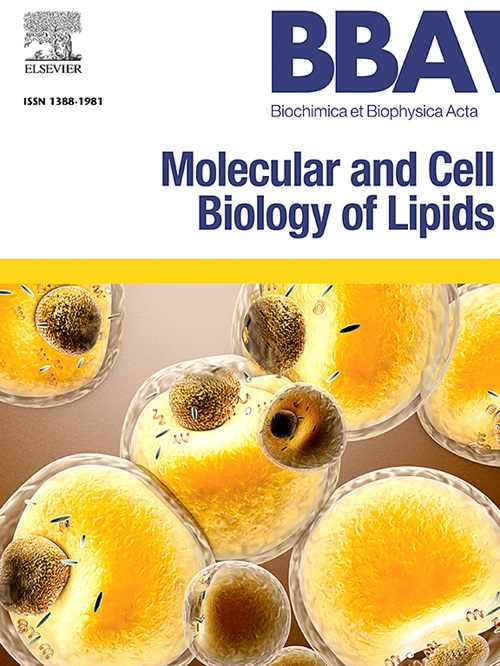从 LAL-D 到 MASLD:洞察 LAL 和 Kupffer 细胞在肝脏炎症和脂质代谢中的作用。
IF 3.3
2区 生物学
Q2 BIOCHEMISTRY & MOLECULAR BIOLOGY
Biochimica et biophysica acta. Molecular and cell biology of lipids
Pub Date : 2024-10-31
DOI:10.1016/j.bbalip.2024.159575
引用次数: 0
摘要
代谢功能障碍相关性脂肪性肝病(MASLD)是全球普遍存在的一种肝脏病变,与肥胖和代谢紊乱密切相关。越来越多的证据表明,巨噬细胞在脂肪肝的发病过程中起着至关重要的作用。多项人体研究表明,循环溶酶体酸性脂肪酶(LAL)活性与 MASLD 之间存在反相关关系。已知 LAL 是溶酶体中降解胆固醇酯 (CE) 和三酰甘油的唯一酶。因此,当 LAL 缺乏症(LALD)导致酶降解功能受损时,这些底物就会积聚。本研究旨在探讨肝脏 LAL 活性和肝脏驻留巨噬细胞(即 Kupffer 细胞 (KC))在 MASLD 中的作用。为此,我们分析了肝细胞特异性(hep)Lal-/-小鼠的脂质代谢,并用氯屈膦酸钠处理耗尽了KC。当喂食高脂肪/高胆固醇饮食(HF/HCD)时,肝细胞特异性(hepLal-/-)小鼠表现出CE累积、肝脏中巨噬细胞数量增加以及明显的肝脏炎症。服用氯屈膦酸钠后,KC被耗尽,而浸润/增殖的CD68表达巨噬细胞受到的影响较小。这导致肝脏 CE 积累和血脂异常加剧,表现为低密度脂蛋白胆固醇浓度升高。这些发现与肝组织的蛋白质组分析一起表明,高血脂/高胆固醇血症喂养小鼠的肝LAL-D会导致巨噬细胞向肝脏浸润,而KC消耗会进一步加剧肝CE浓度和血脂异常。本文章由计算机程序翻译,如有差异,请以英文原文为准。
From LAL-D to MASLD: Insights into the role of LAL and Kupffer cells in liver inflammation and lipid metabolism
Metabolic dysfunction-associated steatotic liver disease (MASLD) is a prevalent liver pathology worldwide, closely associated with obesity and metabolic disorders. Increasing evidence suggests that macrophages play a crucial role in the development of MASLD. Several human studies have shown an inverse correlation between circulating lysosomal acid lipase (LAL) activity and MASLD. LAL is the sole enzyme known to degrade cholesteryl esters (CE) and triacylglycerols in lysosomes. Consequently, these substrates accumulate when their enzymatic degradation is impaired due to LAL deficiency (LAL![]() D). This study aimed to investigate the role of hepatic LAL activity and liver-resident macrophages (i.e., Kupffer cells (KC)) in MASLD. To this end, we analyzed lipid metabolism in hepatocyte-specific (hep)Lal−/− mice and depleted KC with clodronate treatment. When fed a high-fat/high-cholesterol diet (HF/HCD), hepLal−/− mice exhibited CE accumulation and an increased number of macrophages in the liver and significant hepatic inflammation. KC were depleted upon clodronate administration, whereas infiltrating/proliferating CD68-expressing macrophages were less affected. This led to exacerbated hepatic CE accumulation and dyslipidemia, as evidenced by increased LDL-cholesterol concentrations. Along with proteomic analysis of liver tissue, these findings indicate that hepatic LAL-D in HF/HCD-fed mice leads to macrophage infiltration into the liver and that KC depletion further exacerbates hepatic CE concentrations and dyslipidemia.
D). This study aimed to investigate the role of hepatic LAL activity and liver-resident macrophages (i.e., Kupffer cells (KC)) in MASLD. To this end, we analyzed lipid metabolism in hepatocyte-specific (hep)Lal−/− mice and depleted KC with clodronate treatment. When fed a high-fat/high-cholesterol diet (HF/HCD), hepLal−/− mice exhibited CE accumulation and an increased number of macrophages in the liver and significant hepatic inflammation. KC were depleted upon clodronate administration, whereas infiltrating/proliferating CD68-expressing macrophages were less affected. This led to exacerbated hepatic CE accumulation and dyslipidemia, as evidenced by increased LDL-cholesterol concentrations. Along with proteomic analysis of liver tissue, these findings indicate that hepatic LAL-D in HF/HCD-fed mice leads to macrophage infiltration into the liver and that KC depletion further exacerbates hepatic CE concentrations and dyslipidemia.
求助全文
通过发布文献求助,成功后即可免费获取论文全文。
去求助
来源期刊
CiteScore
11.00
自引率
2.10%
发文量
109
审稿时长
53 days
期刊介绍:
BBA Molecular and Cell Biology of Lipids publishes papers on original research dealing with novel aspects of molecular genetics related to the lipidome, the biosynthesis of lipids, the role of lipids in cells and whole organisms, the regulation of lipid metabolism and function, and lipidomics in all organisms. Manuscripts should significantly advance the understanding of the molecular mechanisms underlying biological processes in which lipids are involved. Papers detailing novel methodology must report significant biochemical, molecular, or functional insight in the area of lipids.

 求助内容:
求助内容: 应助结果提醒方式:
应助结果提醒方式:


